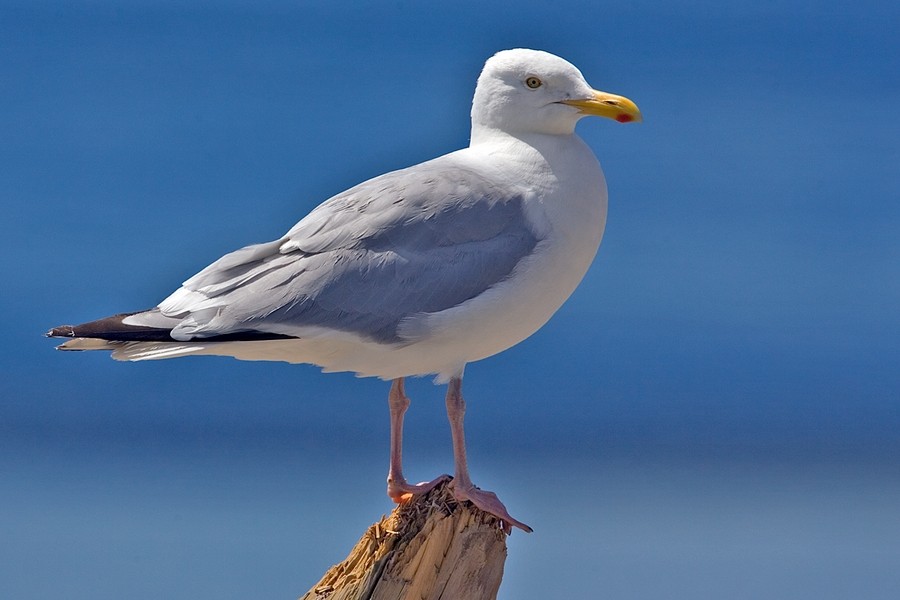American Herring Gull
A species of Gulls Scientific name : Larus smithsonianus Genus : Gulls
American Herring Gull, A species of Gulls
Botanical name: Larus smithsonianus
Genus: Gulls
Content
Description General Info
 Photo By Alan D. Wilson, www.naturespicsonline.com , used under CC-BY-SA-2.5 /Cropped and compressed from original
Photo By Alan D. Wilson, www.naturespicsonline.com , used under CC-BY-SA-2.5 /Cropped and compressed from original Description
It is a heavily built large gull with a long powerful bill, full chest and sloping forehead. Males are 60–66 cm (24–26 in) long and weigh 1,050–1,650 g (2.31–3.64 lb). Females are 53–62 cm (21–24 in) long and weigh 600–900 g (1.3–2.0 lb). The wingspan is 120 to 155 cm (47 to 61 in). Among standard measurements, the wing chord is 41.2 to 46.8 cm (16.2 to 18.4 in), the bill is 4.4 to 6.2 cm (1.7 to 2.4 in) and the tarsus is 5.5 to 7.6 cm (2.2 to 3.0 in). Breeding adults have a white head, rump, tail, and underparts and a pale gray back and upperwings. The wingtips are black with white spots known as "mirrors" and the trailing edge of the wing is white. The underwing is grayish with dark tips to the outer primary feathers. The legs and feet are normally pink but can have a bluish tinge, or occasionally be yellow. The bill is yellow with a red spot on the lower mandible. The eye is bright, pale to medium yellow, with a bare yellow or orange ring around it. In winter, the head and neck are streaked with brown. Young birds take four years to reach fully adult plumage. During this time they go through several plumage stages and can be very variable in appearance. First-winter birds are gray-brown with a dark tail, a brown rump with dark bars, dark outer primaries and pale inner primaries, dark eyes, and a dark bill, which usually develops a paler base through the winter. The head is often paler than the body. Second-winter birds typically have a pale eye, pale bill with black tip, pale head and begin to show gray feathers on the back. Third-winter birds are closer to adults but still have some black on the bill and brown on the body and wings and have a black band on the tail. 
Size
60-66 cm (male), 53-62 cm (female)
Life Expectancy
49 years
Nest Placement
Ground
Feeding Habits
American Herring Gull consume a varied diet including marine invertebrates, fish like capelin and alewife, as well as crabs, mussels, and squid. They also scavenge on carrion and human refuse, showing opportunistic feeding behaviors and a preference for easy meals.
Habitat
Colonies near water on coasts, islands, cliffs, rooftops in some cities, sea, beaches, mudflats, lakes, rivers, fields, refuse dumps 
Dite type
Scavenger
General Info
Feeding Habits
Bird food type
Distribution Area
The breeding range extends across the northern part of North America from central and southern Alaska to the Great Lakes and north-east coast of the United States from Maine south to North Carolina. It breeds over most of Canada apart from the southwest and Arctic regions. Birds are present all year in southern Alaska, the Great Lakes and north-east USA but most birds winter to the south of the breeding range as far as Mexico with small numbers reaching Hawaii, Central America and the West Indies. Vagrants have reached Colombia and Venezuela and there is a report from Ecuador and another from Peru. The first European record was of a bird ringed in New Brunswick which was caught on a boat in Spanish waters in 1937 and there have been a number of additional records from Western Europe since 1990. The first British record was in 1994 in Cheshire. It usually nests in colonies near water on coasts, islands, and cliffs. It also nests on rooftops in some cities. It feeds at sea and on beaches, mudflats, lakes, rivers, fields, and refuse dumps. It roosts in open areas close to feeding sites. 
Species Status
The species became quite rare during the 19th century when it was hunted for its eggs and feathers. From the 1930s to 1960s, it increased rapidly due to protection from hunting, increased waste from fisheries to feed on, and less competition for small fish and invertebrates as humans reduced the populations of large fish, whales, and pinnipeds (seals). Numbers leveled off during the 1970s and 80s and may now be declining in some areas. 

 Photo By Alan D. Wilson, www.naturespicsonline.com , used under CC-BY-SA-2.5 /Cropped and compressed from original
Photo By Alan D. Wilson, www.naturespicsonline.com , used under CC-BY-SA-2.5 /Cropped and compressed from original Scientific Classification
Phylum
Chordates Class
Birds Order
Shorebirds Family
Gulls Genus
Gulls Species
American Herring Gull